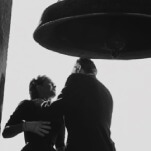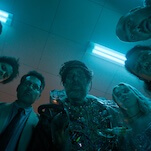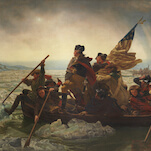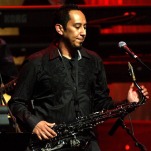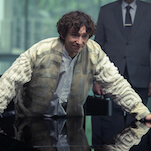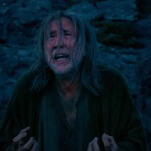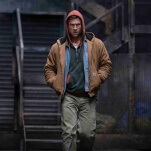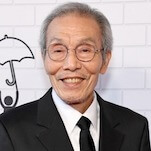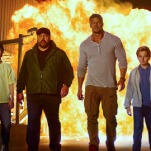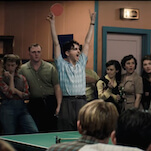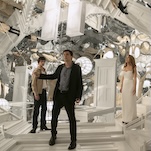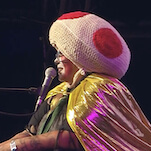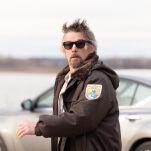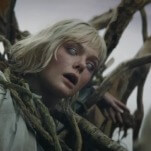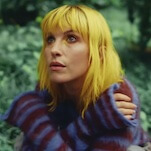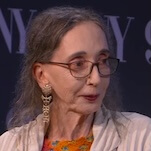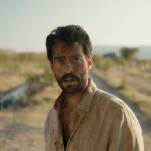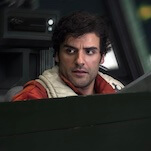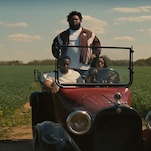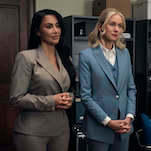When cinematographer Anthony Dod Mantle set out to shoot 28 Days Later in the early aughts, he knew he was taking on a unique challenge. Not only because director Danny Boyle had asked him to play by the rules of a fictional society without electricity—which meant no artificial light—but because Alex Garland’s screenplay was gruesome, infested with wild ideas, and expensive to execute. Boyle and producer Andrew Macdonald didn’t think they could get it all done at the sluggish pace a heavy and well-outfitted cinema camera would afford, be it film or digital.
But Mantle—who came from the Dogme 95 group in Denmark and shot the movement’s seminal launch, The Celebration—had just worked with Boyle on two TV movies, for which he’d used camcorders. So, despite Mantle’s horror-less background, Boyle brought him on as an approach pioneer and asked him to explore. In pursuit of affordability and a fresh modernity at the heart of the project—one that reflected a relatable consumer device experience—Mantle landed on a guerilla, low-resolution DV approach: the Canon XL1 camcorder.
Garland’s infesting mood, production designer Mark Tildesley’s urban apocalypse, Mantle’s maverick camerawork, and Boyle’s puppeteering of it all in horrifying harmony was as contingent on any one of them as it was on Chris Gill’s edit, a patient-yet-sudden, razor-sharp littering of long, body-clinching sequences where pregnant tension is upended by editing tricks that play with pace and effect like Play-Doh: slo-mo, fast motion, repeating whip-like movements, steady-slow wipe transitions, the inexplicable fusion of images. (Editor Jon Harris carried that torch wonderfully in 28 Years Later.)
For his part, Mantle used eight cameras at once to capitalize on the scant time they had to capture London as a ghost town. He shot close-ups underexposed at high shutter speeds with ND filters galore to give the infected a feverish energy—stripping them of cinematic motion blur, which rendered the feeling of the footage faster, darker, and more manic than post effects could have on their own—and chose to keep the camera still more often than not, especially when the viewer expects motion, a sudden left turn for the shaky handheld subgenre. Fixed frames, frozen dutch angles, snail-pace dolly shots, tilts by the centimeter, and pans by the millimeter.”This was not a film that needed any more fear and disaffection due to the camera movement, because there’s already enough of that in the story,” Mantle said.
Over 20 years and five features together later, Boyle gave Mantle a new directive: “You’ve got to find a way of doing something that’s radically, equally relevant and appropriate and different, but honest, for 28 Years Later. What about an iPhone?”
While Years looks like a straight re-teaming between Boyle, Mantle, and Garland at first glance—a seeming recreation of the Days team—a deeper dive gives way to the truth: a drastically different operation led by a largely different team of lead creatives. Only four are back: Boyle, Garland, Mantle, and Macdonald, the only producer credited for the full franchise, and the only producer credited at all for the first. Neither Boyle nor Garland were producers in 2002, rendering the third a whole new beast in approach.
The result is shinier and easier to swallow. But that’s not a demerit; rather, a reflection of modernity in 2025. Nearly a quarter-century since Days, the lines between consumer and prosumer have blurred. Content-driven, influencer-unleashed culture dominates a commercial tech scene that has progressed so significantly that default factory settings on common devices look cinematic on their own. Boyle’s charge was the same: modernize the aesthetic not to the industry, but to the average camera user.
In 1999, The Blair Witch Project popularized the already rising trend of camcorder cinema. Lars von Trier gave the movement more momentum with The Idiots and Dancer In The Dark, Spike Lee with Bamboozled, Takashi Miike with Visitor Q, and Richard Linklater with Tape, among others. But 2002 went nuclear, with films from Abbas Kiarostami, Rebecca Miller, Michael Winterbottom, Steven Soderbergh, Susanne Bier, the Jackass team, and, most famously, Boyle.
The trend would thrive for another several years, culminating in first installments for two major franchises (Paranormal Activity and Cloverfield), an unwieldy arthouse masterpiece from David Lynch that preys on the fear of grainy pitch-blacks in the shadows, and a cult horror classic in [REC] before it largely fell out of fashion. Mantle seemed to lose interest in it too, guiding future collaborators down original prestige aesthetic paths for The Last King Of Scotland, Slumdog Millionaire (for which he won his only Oscar), Antichrist, 127 Hours, Dredd, Trance, and Rush in the most illustrious phase of his career.
While Mantle moved to crisp, high-definition, film-digital blends, Macdonald was shifting the undead franchise in a similar direction. The cinematography of 28 Weeks Later seems as if it were trailing Mantle, eavesdropping, and taking notes on his new style. As a result, 28 Weeks Later looks fantastic, and incidentally manages to embody a 2007-ness in its approach.
Yet, where the modernity of 28 Days Later and 28 Years Later was founded on Mantle’s unrelenting research, Weeks tumbles into its modernity haphazardly as a wanton reflection of burgeoning industry trends. Unlike the others, it strived to be visually clean in its adherence to the new standard studio style emerging at the time, one that looked more Hollywood auteur than traditional horror. And, unlike the others, it stumbled serendipitously into a Hitchockian voyeurism that the other two don’t seem interested in at all.
Days and Years operate within a strict set of creative rules in order to feel like something organically filmed with a remnant of society, such as a camcorder or an iPhone, and found by any one of us. Weeks, on the other hand, simply does it all. Shot on a Sony HVR-Z1E (a convertible HDV/DVCAM camcorder), a 16mm Aaton A-Minima film camera, and a slew of digital ARRIs, the sequel employs dollies, helicopters, cranes, night vision, sniper scope cam, first-person cam, computer cam, re-modernized HD security cam (along with the CCTV cam of the first), green screens, pure FX shots, frenetic handheld motion, floating steadicams, still frames, cameras attached to people, cameras attached to cars—you name it, Weeks tried it.
It could’ve been a disaster, but director Juan Carlos Fresnadillo and DP Enrique Chediak found their own rhythm in the bedlam approach and kept the terror-inducing edge intact. With John Murphy returning as the gloomy-grunge rock score composer, Tildesley returning for production design, and Gill returning for the edit, there’s a throughline between the first two that makes them feel more like spiritual siblings than Days and Years. Weeks was a sleek, impressive studio horror sequel that kept up the left-turn tradition of the franchise, like Years has again, shifting into a synthy, soft-hearted death march.
Mantle shot Years with consumer cameras to get as close to a universal handheld experience as possible, yes, but beware of the factoid that it was simply “shot on an iPhone” and the celebration of homegrown filmmaking bound to follow. Years, like Days, was, indeed, made with the least accessible technology you can imagine—even less accessible than the six-figure cinema cameras they’re opting out of. The iPhone 15 Mantle that B-operator Stefan Ciupek ended up running and gunning with across the arduous, intimately crewed shoot is a Frankenstein’s monster, born through rare access to Apple’s phone camera developers and beta apps by cinema camera manufacturers like Blackmagic. One of the things that makes Mantle’s camera approaches on the two films so worth discussing is how difficult each would be to recreate, how new and novel they actually are.
“It’s not innate to iPhone tech if you shoot with an iPhone straight out of the lens—you know, with the lenses in your phone. You won’t get that,” Mantle said of his complex system. “I had that on one of the set-ups I used because I had to convert an image that comes through a cinema lens and goes into the adapter and then—be it anamorphic or a 1.55 anamorphic, or even if it’s spherical; I make spherical an anamorphic—has to travel through the adapter and it gets flipped onto a glass screen where it then gets re-photographed and, you know, then sorted out from anamorphic, if it’s anamorphic, to an unsqueezed picture. And that all goes on in this incredible app in this iPhone which is pretty amazing.”
They use an even less accessible adapter—described by Mantle as “an off-the-market, bespoke adapter system which can then attach, through a specially manufactured PL mount, real lenses to that”—in tandem with the special mount and a bevy of cinema lenses. Even if you could access this tech, you probably couldn’t afford it. Making matters more complex, Mantle tried all kinds of fresh things with said iPhone, sometimes shooting with up to 20 simultaneously—attached in a semi-circle formation to a wooden board—to heighten the stylized, shuttered bow and arrow kills at the heart of Years’ new brand of hunter-gatherer violence. Yes, technically, Mantle shot Years on an iPhone, but not one we’re familiar with or could use if we wanted.
The same oversimplification trailed Mantle’s use of the prosumer DV camcorder after Days set indie cinema on fire. Like Years‘ version of the iPhone 15, Days‘ version of the Canon XL1 was so modded out and accessorized with cinema gear—in particular, Optex adapters with higher-resolving 16mm Canon EC and EJ prime lenses—that the blindingly colored, bizarro home movie flashback aesthetic has proven too singular for anyone to reproduce.
28 Days Later opens on technology particular to the time, already vintage to Gen Z: the homey fuzz of the ’90s tube TV, saddled with a beer-belly screen that’s distorted through a gritty MiniDV interpretation of a surgically attached 16mm lens, forming alternating light and dark scan lines on the several TVs that surround a lab monkey. The TVs form a mirror reflection of the multi-cam setup on the other side of the lens that Mantle dreamt up.
As if these technical aberrations aren’t enough, Boyle instructs Mantle to point the camera straight through carnival-grade lab glass. Minutes later, in the opening shots of Jim waking up, the extreme close-up camcorder read on the lens gives an impressionistic surf-green edge to the highlights in the frame. Mantle then shoots Jim through a transparent hospital tarp (one reminiscent of the plasticky iterations of The Shimmer that Garland would draw out in Annihilation 16 years later) that’s not there from other angles.
There’s an acid-sunset hue to the light when Jim finally steps outside, accentuated by the camera’s doomy lo-fi look and Mantle’s divorced capture of colorful sky plates. When he wanders into the church, the XL1 picks up natural light through stained glass windows—unplanned, according to Mantle—and finds a nightmarish darkness in the shadows that would’ve made the cut for Inland Empire. The black pits of shadow float in a sea of mangled bodies strewn across the pews, and from them emerges Jim’s first sighting of the Rage-induced, though he doesn’t realize it. The harsh camera gives the darkened priest’s bloodshot eyes a searing-hot surface and picks up fire with a spooky hollowness. With every sequence of the first scene-setting 15 minutes, the aesthetic declares itself boldly, and breathes a lawless life, a misfit energy, into the soul of the film—one as unhinged and hard to look away from as the infected themselves.
The strange, unforgettable look gives gradients to the sky, creates stunningly lifelike watercolor impressionism in natural wides, and picks up rain with an action-packed edge, like bullets hurtling through the frame. When the men become the monsters at the end, and Jim, in turn, becomes their monster—shirtless, splayed with blood, eyes wild, allied with the infected—the darkness in the dirty, sizzling DV grain houses fear and harbors potential danger in and around every corner. On the flip side of that coin, the immediacy of the recurring lightning strikes burst on the screen with an atmospheric glow. The pervasive canary yellows have a saturated acerbity to them that don’t inspire the calm, bright, or ease they could’ve with cleaner lenses, a brilliant move that lends the softer moments a disquietude that keeps viewers on the edge of their seats.
In Years, the iPhone grain gets just as fuzzy as DV in its own way. The ribbed flares of iPhone-based anamorphic lensing are brand-new cinema tech artifacts that dance across the compositions in rigid formation. A defining, gentle glow merges with the dew of the dense mainland forest and the radiance of the Northern Lights that have re-emerged in a sky free from light pollution.
To invoke modernity in a different way, militant archival footage is woven through various eerie shots of father and son crossing over into the mainland, invoking a contemporary online experience that resembles quickly scrolling through a thousand different aesthetics swiftly identified by their time period or insignia. Mantle also creatively employed the iPhone’s ability to capture timelapses, shoot a finger’s length away from its subjects with ultra-wide lenses, and soar through the air with ease. They used drones to shoot aerials, found old Panavision cameras to capture blood-red night vision, and, for the first time in the franchise, set up an extensively post-produced action sequence in a giant, 450-ft COVID-vaccination-center-turned-sound-stage.
“We had cranes and tracks down the side. I had two dollies working at the same time. I had two technocranes. We had the bar cam, which is the array of iPhones, also on the technocrane, which is a pretty savage decision, because that’s moving at speed, wrapped around the head of Aaron Taylor-Johnson, or the Alpha. It’s pretty scary. But we did it,” Mantle said. To make matters more impressive, they worked with an astronomy center to source real night sky plates of the Northern Lights for post-production and lit the stage during production as if they were already there.
The franchise is now moving ahead, like it once did, under Macdonald and without Boyle or Mantle. Years is not the end of an old trilogy, but the first of a new trilogy that’s already been penned by Garland. Nia DaCosta and veteran DP Sean Bobbitt, who typically shoots for Steve McQueen, shot the fourth installment, 28 Years Later: The Bone Temple, back-to-back with Years as a direct sequel. Set for a January 2026 release, it revives Cillian Murphy as Jim and brings back principal Years players Ralph Fiennes, Alfie Williams, and Taylor-Johnson, picking the story up where the Cult of Jimmies left it. If everything goes according to plan, Boyle—who’s staying on to produce this time—will return to helm the third, and it’s hard to imagine him asking anyone but Mantle to brave the dark with him once again. In that case, only one question remains: How will their new look change the industry this time?

